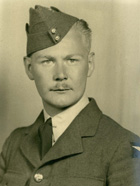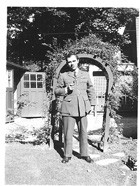RECOVERY AND BURIAL
RECOVERY AND BURIAL OF FLIGHT LIEUTENANT PETER CAMPBELL (ROYAL AIR FORCE) AND LEADING AIRCRAFTSMAN THEODORE BATES (ROYAL CANADIAN AIR FORCE)
On the 12th of December, 1940, Leading Aircraftsman Clayton Hopton went missing during a flight while training out of No. 1 Service Flying Training School, Camp Borden. Camp Borden was one of the main centres used as part of the British Commonwealth Air Training Plan in the Second World War. The following morning, Camp Borden launched a search party to find the missing airman. As part of the search, two aircraft collided over and crashed into Lake Muskoka. The aircrews included:

Douglas (Northrop) Nomad A-17A
aircraft were used by the
search party seeking LAC Hopton.
(Photo: RCAF / ARC)
Nomad 3512
Pilot: Sergeant Lionel Francis, Royal Air Force (RAF); Observer: Leading Aircraftsman (LAC) William Gosling, Royal Canadian Air Force (RCAF)
Nomad 3521
Pilot: Flight Lieutenant Peter Campbell (RAF); Observer: Leading Aircraftsman Theodore (Ted) Scribner Bates (RCAF).
All four airmen were lost in the collision.
A second search was launched, this time to locate the four missing airmen. On the 9th of January, 1941, divers confirmed the location of the Nomad 3512 in 32 metres of water in Lake Muskoka. It was not until April and June that the aircraft, and the bodies of two of the airmen, LAC Gosling and Sgt. Francis, were able to be recovered. Despite weeks of surveying the lakebed, the second aircraft was never found, and the names of LAC Bates and F/Lt Campbell were listed on the Ottawa Memorial to the missing.

Leading Aircraftsman
Theodore Bates,
Royal Canadian Air Force
(Photo: Used with the
permission of the Bates Family)

Flight Lieutenant
Peter Campbell,
Royal Air Force
(Photo: Used with the permission
of the Campbell Family)
LOCAL INTEREST
A renewed interest in the aviation history of the Muskoka region began with members of a local group, Lost Airmen of Muskoka Project – Al Bacon and Matt Fairbrass. Their focus was to highlight the sacrifices made by local wartime airmen flying out of Muskoka Airport – and later, those who had lost their lives flying out of Camp Borden.
The Underwater Search and Recovery Unit (Orillia) of the Ontario Provincial Police undertook the renewed search for the 3521 and over a two year period, using a variety of techniques, including side scan sonar, were able to map the lakebed surrounding the potential crash site in Lake Muskoka. In late July 2010, the USRU team confirmed the location of wreckage through several dives in which they found personal items belonging to each airmen. Items included a gold ring inscribed with LAC Bates’ initials; as well as a silver-plated cigarette case with F/Lt Campbell’s birthday and initials engraved on the inside cover.
The USRU promptly contacted the Directorate of History and Heritage (DHH) at the Department of National Defence – who began planning the recovery of the airmen.
RECOVERY

Members of the
Fleet Diving Unit
(Atlantic) prepare for
a third day of diving on
Lake Muskoka (October 2012).
(Photo: Melanie Villeneuve)
From 10-18 October 2012, Canadian Armed Forces divers from the Fleet Diving Unit (Atlantic) conducted a survey on the site of the Nomad with the assistance of the OPP USRU and forensic scientists from the Directorate of History and Heritage. The remains were examined and cleared by the Ontario Pathology Service, and both families were notified.

MS Danny Landry,
PO2 Yves Bernard
and Lt(N) Greg Richards
assist CPO1 Charlie Trombley
on the third day of
diving on Lake Muskoka.
(Photo: Melanie Villeneuve)
INTERMENT
Campbell and Bates were interred in a modest military ceremony on September 17th, 2013, at Woodlawn Memorial Park Cemetery in Guelph. The family of F/Lt. Campbell chose to inter the remains of their uncle next to the airman with whom he flew (war-time service personnel from the Commonwealth cannot be repatriated). Attending the service were many family members, including the brother, nephew and grand-nephew of LAC Bates, and the nieces, nephews and cousins of F/Lt. Peter Campbell. Also attending was the Mayor of Guelph, Dr. Karen Farbridge; the senior Defence Representative of the United Kingdom, Brigadier Le Grys , the Director of Curriculum of the Canadian Forces College, Colonel Sukstorf (RCAF) and members of the OPP Dive Unit and the Directorate of History and Heritage.




